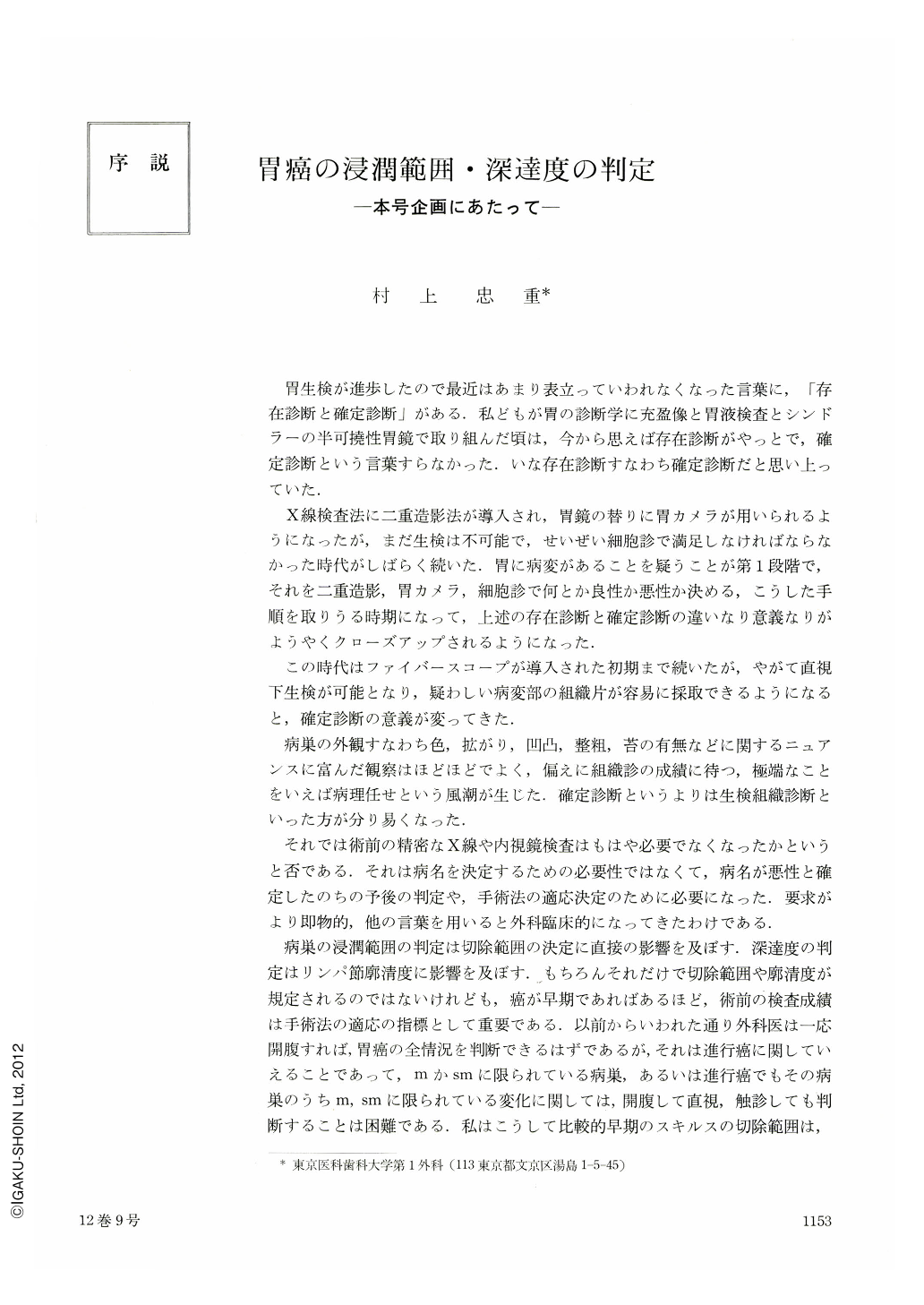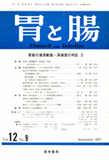Japanese
English
- 有料閲覧
- Abstract 文献概要
- 1ページ目 Look Inside
胃生検が進歩したので最近はあまり表立っていわれなくなった言葉に,「存在診断と確定診断」がある.私どもが胃の診断学に充盈像と胃液検査とシンドラーの半可僥性胃鏡で取り組んだ頃は,今から思えば存在診断がやっとで,確定診断という言葉すらなかった.いな存在診断すなわち確定診断だと思い上っていた.
X線検査法に二重造影法が導入され,胃鏡の替りに胃カメラが用いられるようになったが,まだ生検は不可能で,せいぜい細胞診で満足しなければならなかった時代がしばらく続いた.胃に病変があることを疑うことが第1段階で,それを二重造影,胃カメラ,細胞診で何とか良性か悪性か決める,こうした手順を取りうる時期になって,上述の存在診断と確定診断の違いなり意義なりがようやくクローズアップされるようになった.
There are a certain terms, “existence diagnosis” and “definitive diagnosis” of cancer, which have been less frequently used today, upon progress of gastric biopsy. Viewing back to those days when we struggled to make a diagnosis of gastric cancer with a combination of fill-up X-ray of the stomach, gastric analysis, and occasionally semi-flexible gastroscope of Schindler, we had to be satisfied with “existence diagnosis” at most, and there did not exist even the term of “difinitive diagnosis”. Rather, “existence diagnosis” was considered as if equivalent to “definitive diagnosis”. Following this immature days of diagnosis of gastric cancer, the double-contrast method of the stomach was introduced and the gastrocamera took over the gastroscope. But gastric biopsy was still impossible and we had to be satisfied with cytology for a while. Accumulation of the experiences with these diagnostic steps (double-contrast radiology, gastrocamera, cytology) to determine the nature of the gastric lesion, whether benign or malignant, following the initial suspicion of the lesion, enabled us to recognize the difference between and the significance of “existence diagnosis” and “definitive diagnosis”. This age lasted until the early stage of the introduction of fibergastroscope, and soon the concept of the “definitive diagnosis” became changed when the biopsy under direct vision became feasible and pieces of the tissue was easily obtained from the suspected lesion. Delicate appearance of the lesion through endoscope such as the color, extent, eveness or uneveness, regularity or irregularity, presence of coating were not considered necessarily to be strict, and the principal importance was rather given to the histological diagnosis of the biopsy specimen instead. In other words, there appeared a trend only to wait for histology report, namely dependency on pathology. “Histological diagnosis of th biopsy specimen” was considered to be more proper and understandable term than the term of “definitive diagnosis”. Then, are the preoperative precise radiological as well as endoscopic examinations not necessary any more ? Yes, they are absolutely necessary. Now they are not necessary for making diagnosis but rather for the determination of operative indication and the judgment of prognosis after the diagnosis of malignancy was established. The extent of infiltration will be a major determinant of the extent of resection. The preoperative estimate of the depth of infiltration can be a major determinant of the extent of dissection of lymph nodes. Needless to say, these preoperative informations will not be a sole determinant for the extent of resection and lymph node dissection, but the more valuable they will be as an index to select the operative procedure, the earlier the stage of cancer.
As stated before, the surgeon can make a proper judgment on a whole aspect of gastric cancer, once the abdomen is opened. But this can be only true in case of advanced gastric cancer. When cancer is localized within mucosa (m) or submucosa (sm) or as for the part of lesion located within mucosa (m) or submucosa (sm) even in case of advanced cancer, it will be extremely difficult to make a proper judgment based on palpation or under direct vision by gastrotomy during laparotomy. Consequently, in case of scirrhous cancer of relatively early stage, I personally place more importance on preoperative radiologic and endoscopic findings in order to dertermine the extent of resection, and always ask my colleagues to follow this principle.
Even through a remarkable progress will be made in preoperative examinations, the precise differentiation between pm(proper muscle layer) and s (serosa) lesions will not be possible for a while. A plea should be made by all means to see the days will come soon when the precise differentiation between them will be possible. However, we have a strong belief that the differentiation between sm and pm is now possible, and I expect the papers collected here will reveal such a result. If this is really impossible, I am afraid the concept of early gastric cancer must be spoiled. In fact, this differentiation will not always be easy, as the term “early-gastric-cancer-mimetic advanced cancer” does exist. Generally, it is possible to differentiate depending on whether or not there are any limitation in the movement of proper muscle layer. But the once the ulcerative process involves the proper muscle layer, this “possibility” is no longer valid. Then, how can we reach the proper solution of this problem ? In this circumstances, it might be a general rule to follow the reverse way from the specific to the general in order to find a proper solution, if the problem can not be solved by the orthodox way. In each type of Ⅰ, Ⅱa, Ⅱc, Ⅲ, and further Ⅱa-Ⅱc, Ⅱc+Ⅱa, Ⅱc+Ⅲ, Ⅲ+Ⅱc etc., it will be necessary to set a certain criterion for estimation of the depth of invasion, and thereafter to deduce the general rule.
As you know, annoying concept of TNM classification has been introduced by UICC. The basic principle of this classification is based on the stage of cancer determined by the preoperative findings to estimate the prognosis. There will not be any troubles if it will be applied only for thyroid or breast cancer, but since the classification has also been applied for the visceral cancers, these happened controversy. Among the visceral cancers, lung cancer which is easily visualized on X-ray or uterine cancer which is also quite accessible will not be difficult to be classified, but ovarial cancer will no longer be possible to be classified. Moreover, another possible application of this classification to esophageal or gastric cancer came to mind in UICC and asked this trial to Japan where the level of diagnosis of these cancers is most progressed. At first, we rejected this inquiry as it would be too difficult and suggested to correlate postoperative long-term result with operative findings and histopathological observations on surgical specimen. But Denoix did not accept out suggestion and forced us to make a trial, insisting the principle of TNM classification is perfect.
Following unwilling but intensive analysis, we concluded that the classification of early gastric cancer we proposed was the most reliable index to estimate 5-year survival rate. The more advanced cancer too was found to be closely related to the survival rate, if it was classified into the stages by the extent on the mucosal surface. Thereafter, arguements arose mainly from the United States that the differentiation between sm and pm lesions would be difficult and that the depth of invasion could only be determined on histopathological examination of the surgical specimen and it could not be done preoperatively. The papers collected in this special issue shoud be most reliable evidences to support our reply. I am having a secret desire that the conclusions will suggest at least 80~90% possibility, though it may not be 100 % possible. Every effort should be attempted as the diagnostic procedure such as double-contrast method, compression method, combined use of muscle relaxant, multi-directional X-ray, ingeneous techniques in endoscopy (staining with dye, intramucosal carbon black injection etc.), biopsy, and some statistical analysis. I sincerely hope that protean nature of cancer should be unmasked in this special issue. We must show our backbone in this field, since we have first proposed the category of early gastric cancer.
I am afraid that over-excitement was brought into the scientific matter but this is only from my earnest desire to have superb discussion on the urgent subject stated above.

Copyright © 1977, Igaku-Shoin Ltd. All rights reserved.


